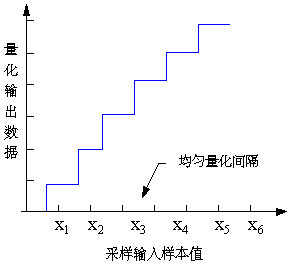ADPCM算法浅析
ADPCM算法浅析
1. ADPCM算法简介
1.1 脉冲编码调制(PCM)的概念
在上图中:
- 输入是模拟信号,输出是PCM样本。
- 防失真滤波器:低通滤波器,用来滤除声音频带以外的信号
- 波形编码器:可理解为采样器
- 量化器:可理解为“量化阶大小(step-size)”生成器或者称为“量化间隔”生成器
PCM实际上是模拟信号数字化:
- 第一步是采样,就是每隔一段时间间隔读一次声音的幅度
- 第二步是量化,就是把采样得到的声音信号幅度转换成数字值
1.2 量化的方法
量化的方法主要有均匀量化和非均匀量化。
均匀量化:
- 采用相等的量化间隔/等分尺度量采样得到的信号幅度,也称为线性量化。
- 量化后的样本值Y和原始值X的差E=Y-X称为量化误差或量化噪声

非均匀量化
- 大的输入信号采用大的量化间隔,小的输入信号采用小的量化间隔
- 可在满足精度要求的情况下用较少的位数来表示
- 声音数据还原时,采用相同的规则
- 采样输入信号幅度和量化输出数据之间定义了两种对应关系(μ律压扩算法,A律压扩算法)注:压扩(companding)

μ律压扩
- μ律(μ -Law)压扩(G.711)主要用在北美和日本等地区的数字电话通信中,按下式确定量化输入和输出的关系:
x为输入信号幅度,规格化成 sgn(x)为x的极性;
sgn(x)为x的极性; - u为确定压缩量的参数,它反映最大量化间隔和最小量化间隔之比,取100≤u≤500。
- 由于u律压扩的输入和输出关系是对数关系,所以这种编码又称为对数PCM。具体计算时,用u=255,把对数曲线变成8条折线以简化计算过程。
A律压扩
- A律(A-Law)压扩(G.711)主要用在欧洲和中国大陆等地区的数字电话通信中,按下式确定量化输入和输出的关系:
 0≤ |x|≤1/A
0≤ |x|≤1/A
 1/A < |x|≤1
1/A < |x|≤1 - x为输入信号幅度,规格化成 -1≤x≤1; sgn(x)为x的极性。
- A为确定压缩量的参数,它反映最大量化间隔和最小量化间隔之比。
小结:PCM编码早期主要用于话音通信中的多路复用。一般来说,在电信网中传输媒体线路费用约占总成本的65%,设备费用约占成本的35%,因此提高线路利用率是一个重要课题。
1.3 自适应差分脉冲编码调制(ADPCM)的概念
- ADPCM的中文术语为自适应差分脉冲编码调制
- adaptive difference pulse code modulation的缩写
- 综合了APCM的自适应特性和DPCM系统的差分特性,是一种性能比较好的波形编码技术
它的核心想法是:
- 利用自适应的思想改变量化阶的大小,即使用小的量化阶(step-size)去编码小的差值,使用大的量化阶去编码大的差值。
- 使用过去的样本值估算下一个输入样本的预测值,使实际样本值和预测值之间的差值总是最小
1.4 ADPCM编码框图
接收端的译码器使用与发送端相同的算法,利用传送来的信号来确定量化器和逆量化器中的量化阶大小,并且用它来预测下一个接收信号的预测值。

2 ADPCM代码实现
2.1 ADPCM编码程序逻辑
由待编码文件的起始部分开始,依次读取长度为len的数据段,送入adpcm_encoder,得到编码后的数据,并将结果存入中间文件,直到待编码文件的所有部分都已编码完成。
adpcm_reset(); //此函数只需在编码开始前调用一次
while(待编码文件未读完)
{
读取长度为len的数据段,存入固定的数组内;
执行adpcm_encoder,得到编码后的数据段,以及编码后的数据段长度len_2;
将编码后的数据段顺次存入中间文件内;
}
2.2 ADPCM解码程序逻辑
由中间文件的起始部分开始,依次读取长度为len_2的数据段,送入adpcm_decoder,得到编码后的数据,并将结果存入最终文件,直到中间文件的所有部分都已解码完成。
while(中间文件未读完)
{
读取长度为len_2的数据段,存入固定的数组内;
执行adpcm_decoder,得到解码后的数据段;
将解码后的数据段顺次存入最终文件内;
}2.3 代码示例
//#include 3 ADPCM解码算法在某蓝牙主设备上的应用
3.1 待解包的帧格式
data[0] = 0x88 // 帧头部
data[1] // 帧编号,范围0x00-0xff
data[2]~data[21] // 编码后的数据域,20字节
data[22] = 0x0d // 帧尾部第1字节
data[23] = 0x0a // 帧尾部第2字节3.2 示例代码
截取有效数据域:
#define ADPCM_GROUP_SIZE 60
#define ADPCM_FRAME_SIZE 20
#define ADPCM_GROUP_FRAME_NUM 3
#define ADPCM_GROUP_HEADER_SIZE 2
#define ADPCM_GROUP_TAILER_SIZE 2
if (ulReadFileSize < ulSBCTempFileSize)
{
if (ucADPCM_CheckIfFindGroupHeader(fTemp))
{
fseek(fTemp, (ADPCM_FRAME_SIZE + ADPCM_GROUP_HEADER_SIZE), SEEK_CUR);
if (ucADPCM_CheckIfFindGroupTail(fTemp))
{
usFrameCnt++;
fseek(fTemp, -ADPCM_FRAME_SIZE, SEEK_CUR);
fread(ucADPCMBuffer, ADPCM_FRAME_SIZE, 1, fTemp);
fseek(fTemp, ADPCM_GROUP_TAILER_SIZE, SEEK_CUR);
ulReadFileSize += (ADPCM_FRAME_SIZE+ ADPCM_GROUP_TAILER_SIZE + ADPCM_GROUP_HEADER_SIZE);
ulSBCVoiceDataSize += ADPCM_FRAME_SIZE;
ucDecodeState = DECODE_STATE_DECODE_ONE_GROUP;
ulADPCMBufferLen = ADPCM_FRAME_SIZE;
}
else
{
fseek(fTemp, -(ADPCM_FRAME_SIZE + ADPCM_GROUP_HEADER_SIZE - 1), SEEK_CUR);
usIncompleteFrameCnt++;
}
}
else
{
//s_ucADPCMFrameCnt = 0;
fseek(fTemp, 1, SEEK_CUR);
ulReadFileSize++;
}
printf("Incomplete Group = %d, Total Group cnt = %d, ulReadFileSize = %d\r", usIncompleteFrameCnt, usFrameCnt,ulReadFileSize);
}
else
{
ucDecodeState = DECODE_STATE_DECODE_SUCCESS;
}解码:
INT16 usDecodedBuffer[ADPCM_FRAME_SIZE*2];
adpcm_decoder(ucADPCMBuffer, usDecodedBuffer, ADPCM_FRAME_SIZE);4 如何理解ADPCM
- ADPCM可以将40个量化精度为16bit的采样值压缩到20Byte,压缩比是4:1
- 假设有40个量化精度为16bit的采样值,这里表示为short sample[40],用ADPCM算法压缩后用encoded_sample[20]表示。encoded_sample[0]和encoded_sample[1]分别存储sample[0]的高字节和低字节。从encoded_sample[2]开始,每个字节的高4位和低4位分别存储了1个sample的特征参数,且后一个sample的特征参数的值是前一个sample特征参数的函数。
- 基于上一点,如果压缩后的encoded_sample[20]在传输过程中出现丢失或误码,就会导致解码后的数据严重失真。所以在传输时建议采用可靠连接,即需要保证每次传输都被正确接收。
5 参考文献
1. 复旦大学课件——话音编码.ppt
2. Audio Signal Processing and Coding.pdf
3. MP3编码算法分析.zip
4. ADPCM文件解码详解
